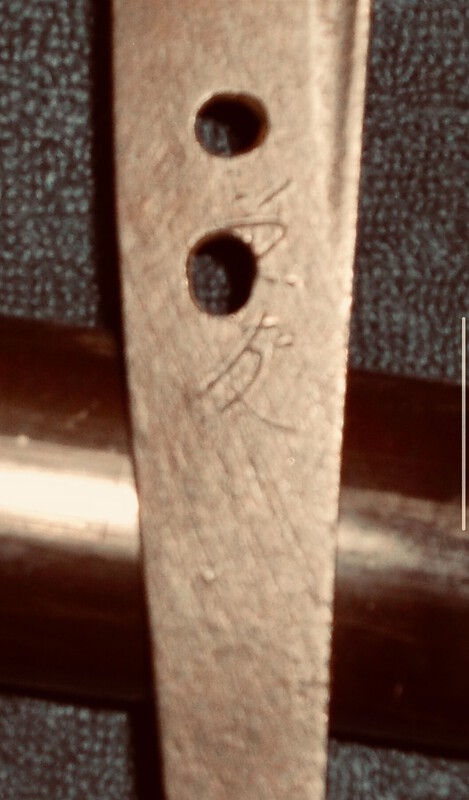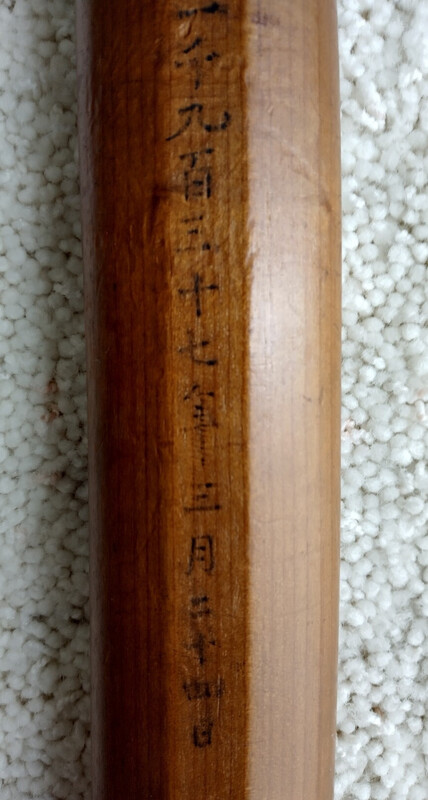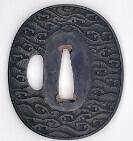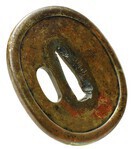All Activity
- Past hour
-
The Horyu paperwork clearly says there is a last kanji in the date, but that they cannot read it, using an open mouth box to indicate this i.e. 徳治三+口 I have found in the past that experimentation with different lighting conditions can (faintly) bring up a character that shinsa teams do not have the time to properly investigate. Certainly with just one dark photograph of your nakago, we here do not have a chance, but you, with time and patience, might. .
-
Thank you Moriyama Sama for Nebiki-matsu, that is the word I was looking for! (Shown also in Dale's guard with the roots encased as Kadomatsu).
-
Dear Brian. A nice thjing. Some more information here to compare. https://www.mandarinmansion.com/item/hirado-kunishige-fuchi All the best.
- Today
-
Need Translation of WWII Samurai Sword Tang Symbols
Ashley Le Boydre replied to Isley's topic in Translation Assistance
Thanks for everything. I got the numbers, didn't know they were the assembly numbers. Greatly appreciated. Really wanted to confirm the top 2 and bottom two symbols. Thanks again. Regards Ash -
I can check the literature but I most commonly encountered 1317. Possibly because of the partial date signature blade? Or because Kunihiro starting to date his blades in 1318, the assumption he was a student of Kunimitsu until then and not an independent master? The earliest dated blade (1293?) makes it a plausible 30 year run. But then there are so many blades of his even at TH level, its probably was a larger school. Two generations? Kunihiro and others(?) working under Kunimitsu's patronage?
-
Akaryu started following Japanese Old Sword Database
-
Thank you very much for sharing this very impressive work!
-
-
The only way to know for sure are swords with: direct provenance to a battle or incident swords with Kiritsuke Mei noting a specific engagement ikido-tameshi (cutting test on a live body) signs of battle such as multiple Kirikomi or Hakobore Anything beyond this is well within the realms of idle speculation. Swords carried during WWII may hold a higher chance of being used to kill people, especially those carried during the China campaign. Once again true evidence is required to confirm this. Sword in a real fight: http://www.ksky.ne.jp/~sumie99/katanainfight.html Kiritsuke-Mei: https://web.archive.org/web/20201109031925/https://yuhindo.com/osafune-motoshige-katana/ China campaign recollection (not for the faint of heart): https://zzwave.com/cmfweb/wiihist/confess/spies.html
-
Its an interesting question and there are a few things to consider. First, Japanese have extensive records on battle casualties from Nanbokucho to late Muromachi, from various sources. In Nanbokucho for example after sometime in service you would write a letter detailing your wounds, lost equipment, kills, tropheys taken. Which today produces many Ph.Ds dealing with these letters. By memory swords in their most effective periods go to like 35% of total casualties, but generally oscillate between 5 and 20%. The rest are bows, later yari etc.. In Nambokucho there is surprising percentage of stones, axes and other tools that are seldom imagined. Also, most surviving swordsmen (i.e. capable of leaving a record) even in Nambokucho would have zero kills, and people with five+ claimed kills would be around 5% of the fighting force. Second, swords overall are not made to survive battles. European sword some people estimate to survives 3 active engagements on average. Japanese are generally much more prone to hagire and catastrophic chipping so it is comparable at best. However, we are dealing with survivors - so either blades which never killed and thus were preserved, or the blades which somehow killed successfully. So Edo period sword obviously probably never killed. Muromachi - we are talking about huge supply of swords, yet 5-10% sword casualty rates and most sword construction being cheap and iffy enough to be smelted if it kills and chips rather than being repolished. Its probably sub 1% chance it killed. Nanbokucho - there is actually a solid chance it did.
-
I recently bought my first nihonto and am waiting for delivery from Japan that should happen sometime in August. One question that comes up pretty quickly when talking to people (dudes) about my purchase is whether it has ever seen battle or blood. My wife (not a dude) is slightly concerned about bringing something into the house that might have death associated with it. Obviously I have no way of knowing such things unless it was a test cut blade, which was way out of budget even if I wanted it. I don’t want to romanticize death, but it is an interesting question to me. What percentage of blades, by era, were likely to have seen battle or blood over their life? It stands to reason that the older the blade, the more likely it saw battle since many (most?) were modified/shortened to meet the use case of each successive time period. Pre-Sengoku period blades seem to have had many opportunities for battle in my mind, but I am still learning about Japanese history. While Sengoku was the warring states period, I wonder how much of the country was actively battling using swords. I suspect it was still relatively rare overall. I’ve seen listings pointing out kirikomi as a selling point on a blade, but it seems more likely to me that such damage was completely unrelated to actual battle. Forgive my dumb question if it is one, or if it had been discussed before. Thanks! Jeff
-
Now I think that your another possibility is correct. A nebikimatsu (根引き松), that literally means “uprooted pines”, is a traditional Japanese New Year decoration used in Kyoto instead of kadomatsu. It is considered as the origin of kadomatsu. Ref. Nebikimatsu Wiki | Danbooru
-
-
Thanks! Ya’ll are the best Much appreciated, -Sam
-
Agree with 兼-Kane.
-
Thanks a lot everyone. The ideas and input from everyone was amazing. It really took me on a journey through all of the different possibilities. The reverse doesn't provide any additional clues. Dale's example does look quite close, and one really can't discount the "stylized" factor. Thanks again everyone. For what it's worth, there appears to be (what I think is) a small repair using shakudo. I can't say I've seen something like that before, and wonder what might have caused the initial "damage." Damon
-
YourBabyBjornBorg started following Best guess? Ana in the way
-
Hi! This looks like a 兼友/Kanetomo. Edited: A 友 with an extra dot on the upper-right is one of the older ways to write 友, first seen usage from at least the end of the Three Kingdoms time(220 AD~). All of these are from the Tang dynasty (618 - 907 AD), though. It seems that Koto period Kanetomo uses this version more often, with occasional regular 友. (Picture from "Encyclopedia of Mino-Tou")
-
A friend sent me these pictures, and I was hoping to get him a translation. Apologies for the picture quality. Thoughts? -Sam
-
thank you!
-
That's a good question, Thomas. I also have a group photo of the kendo club members and officials. My father won the tournament shown here:
-
I had to use my cell phone instead of the camera to get close enough for these pics. So the photos are segments of side1 and side2 of the saya.......Hope this helps.
-
Quick update: I have been in touch with the auction house. They have agreed to reassess the tsuba and said that they will refund me if they agree with the notes I gave them. I am going to send it back to them today. Fingers crossed. Quite impressed with the willingness to reconsider.
-
I think that Dale has nailed this one. The painting looks almost identical.
-
Toryu2020 started following Sayagaki translation help needed
-
Cool! I wonder if the Honganji still has the tournament records?
-
Still searching.
- Yesterday
-
Sotheby's sale 23 June 1982
Ian B3HR2UH replied to Ian B3HR2UH's topic in General Nihonto Related Discussion
Hi Hamish , not a "Festing " sword I am afraid but one of my tsuba was sold at this auction .





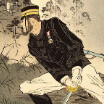









.thumb.png.54593db2789c8a1dcb235543b184ce39.png)



